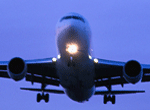The question of ensuring that correct information is being entered into an aircraft’s flight management system has reared up again. Earlier this month, Bloomberg News reported that a computer “technology issue” at United Continental airlines caused some of its pilots to receive an incorrect weight estimate for their flight. The Bloomberg story stated that in one instance, “United sent pilots a weight estimate that assumed the coach section of the Boeing Co. (BA) 737-900 was empty when it was full,” a discrepancy which the pilots didn’t catch for some reason. As a result, the pilots experienced unexpected difficulty in taking off.
Bloomberg also quoted in the story an e-mail from a United spokesperson indicating that incorrect aircraft weight was sent to several flights earlier this year because of incorrect passenger counts.
United has since changed its pre-flight process, and now “is requiring its pilots to perform two additional, manual checks on weight and balance calculations before each flight” to keep the problem from recurring. This is a good idea, since word is that United plans to install narrower seats into its aircraft so it pack in more passengers per plane.
Also earlier this month, The Age reported on the Australian Transport Safety Bureau's release of a report that looked into how the cockpit crew of a departing Qantas Airways Airbus A380 flight from Los Angeles to Melbourne last October failed to realize that required take-off parameters had not been entered into the aircraft’s computer system. As a result, when the aircraft started its take-off roll, most of the flight mode annunciations that should have been present on the primary flight display were absent.
This situation nearly caused a decision to abort the take-off, the ATSB stated, because the aircraft's first officer (FO) "had previously been involved in an event in which a similar lack of annunciation had occurred due to an autothrust failure. Both the captain and FO believed the same failure had occurred during this take-off."
The first officer, the ATSB said, asked the captain whether the take-off should proceed given the possibility of an autothrust failure; the captain responded affirmatively since the "engine thrust setting was at full thrust and there were no warnings or indications of a serious problem."
However, according to the ATSB report, once the A380 reached 100 kts, the captain "realised they did not have the take-off speeds displayed" on the primary flight display, either. Luckily, “the captain and one of the second officers had previously made a written note of the V speeds for the take-off.” With that information in hand, "The second officer called the V1 (decision) speed and both the second officer and captain called the Vr (rotation) speed. The FO rotated and the aircraft responded normally, lifting off at around 159 kts."
It must have been an interesting few seconds there while the notes with the V speeds were searched for.
The ATSB report indicated that the situation arose because of a series of crew distractions and task interruptions that occurred from the time the Airbus 380 left the gate to the time the aircraft was ready to take-off. The disruptions subsequently resulted in the procedures required to set the aircraft’s take-off parameters into the flight management system not to be followed properly (from reading the report, these procedures apparently must be followed in a very specific sequence, something that the cockpit crew apparently didn’t fully appreciate).
In addition, the automated warnings that something was amiss were seen but did not spark the requisite reaction. As the ATSB noted, “Twice prior to takeoff the aircraft's systems displayed a message to check take-off data. The first officer cleared the first message on the understanding that the take-off data would be checked and in the second instance, believing that it had been checked.”
The ATSB states that Airbus has since updated the A380’s flight management warning systems “as part of a planned upgrade program. This upgrade will issue a warning if take-off is commenced without the take-off speeds having been entered into the aircraft's systems.” In addition, Qantas has also updated its A380 standard operating procedures to account for another such situation possibly happening.
In a more recent incident involving Qantas, the Sydney Morning Herald reported this week that the airline has “stood down” two of its Boeing 747-400 pilots. According to the Herald, the pilots were “withdrawn from duty for their argument over the take-off calculations they should have punched into the plane's computer system as it sat on the tarmac at Dallas's international airport,” on August 14th as the plane was waiting to depart to Sydney via Brisbane.
Unfortunately, there are no more details about the argument other than apparently, “It got to a point where the two of them didn't feel they could work together.” Not all problems have technology at their root.
Robert N. Charette is a Contributing Editor to IEEE Spectrum and an acknowledged international authority on information technology and systems risk management. A self-described “risk ecologist,” he is interested in the intersections of business, political, technological, and societal risks. Charette is an award-winning author of multiple books and numerous articles on the subjects of risk management, project and program management, innovation, and entrepreneurship. A Life Senior Member of the IEEE, Charette was a recipient of the IEEE Computer Society’s Golden Core Award in 2008.



